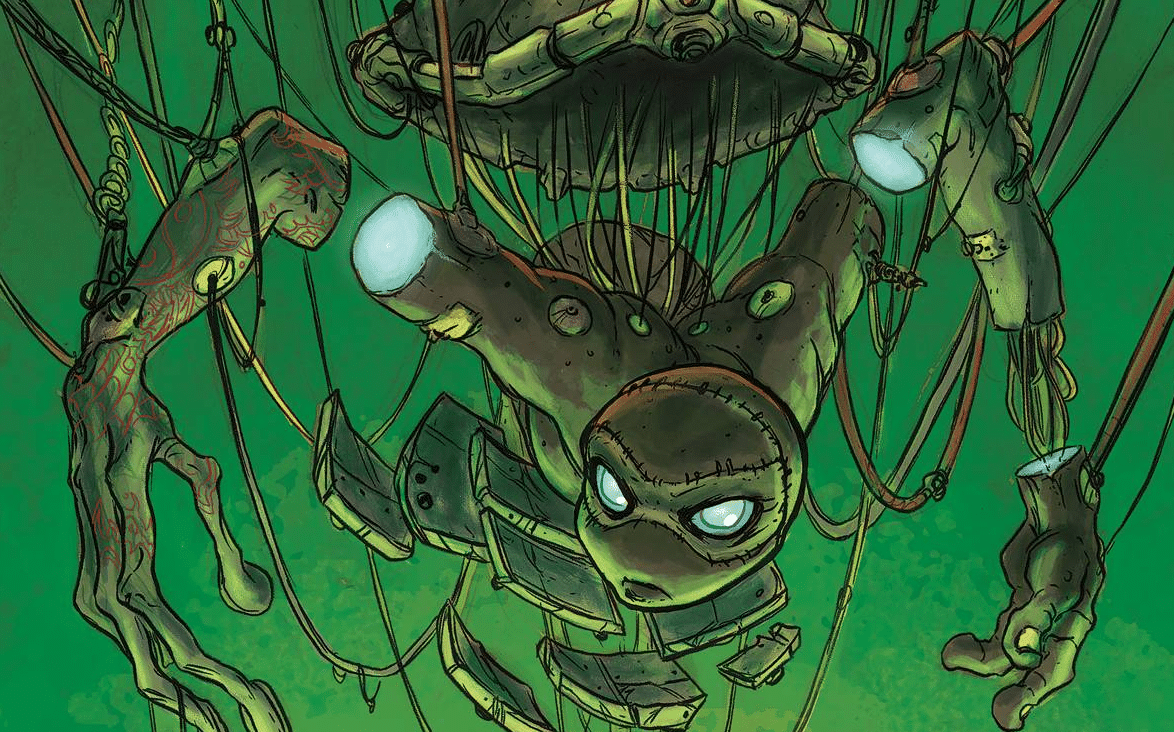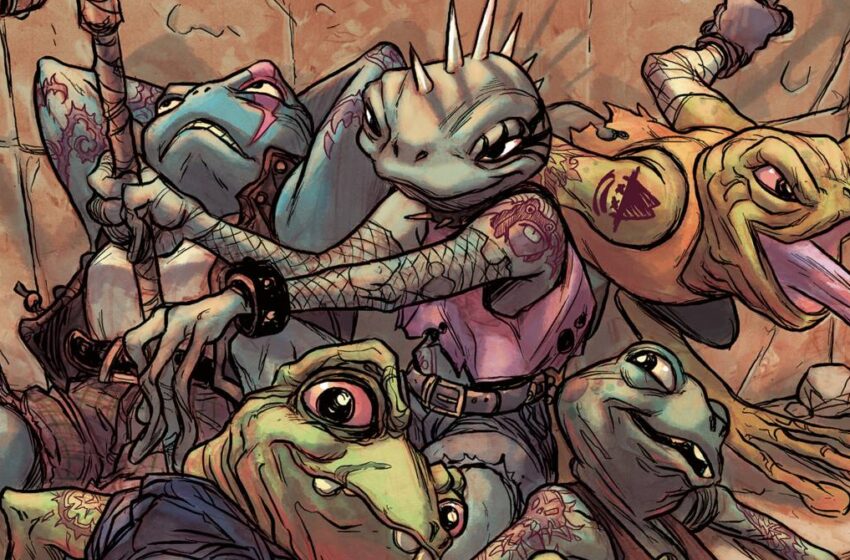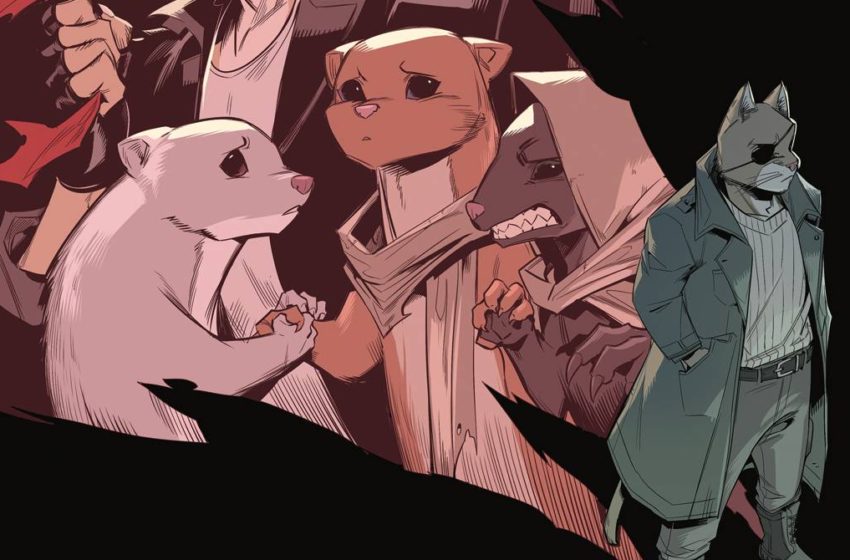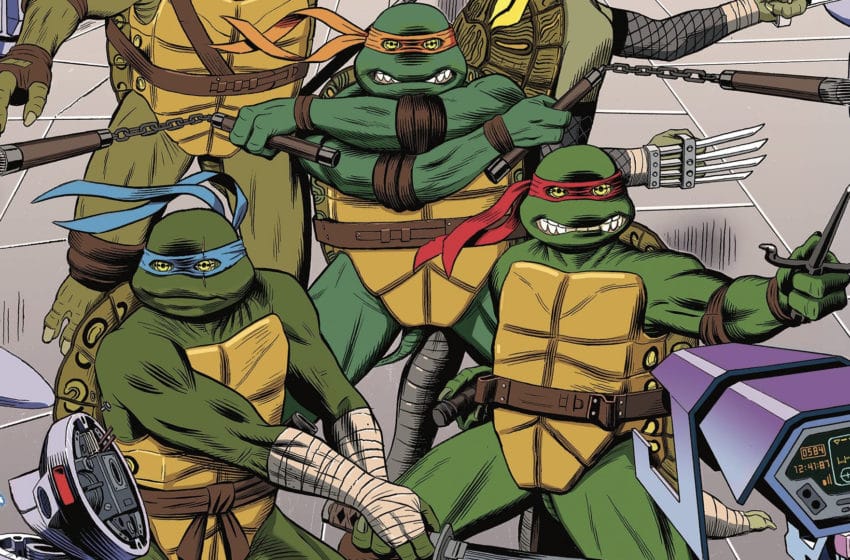It’s been a while since the Turtles had a mad scientist villain to go up against, but Dr. Jasper Barlow is more than making up for lost time. Beware the horrors that lie in store for those of you who dare to read Teenage Mutant Ninja Turtles #127, written by Sophie Campbell, drawn by Pablo Tunica, colored by Ronda Pattison and lettered by Shawn Lee, with story consulting by Kevin Eastman and Tom Waltz.
The adventures of Venus, and the fight against Doctor Barlow continue in Teenage Mutant Ninja Turtles #128, written by Sophie Campbell, drawn by Pablo Tunicia & Sophie Campbell, colored by Patricio Delpeche and lettered by Shawn Lee, with story consulting by Kevin Eastman and Tom Waltz.
It’s also been a while since the four original Turtles went out on a mission together, just the four brothers who started it all. Leonardo rectifies that with a new mission for them, but finding unity after so long apart is a lot harder than it sounds. Teenage Mutant Ninja Turtles Annual 2022, written and drawn by Juni Ba, colored by Ronda Pattison, and lettered by Shawn Lee, with story consulting by Kevin Eastman and Tom Waltz.
With very few exceptions, nobody chooses to be a mutant in IDW’s Teenage Mutant Ninja Turtles universe. It’s something that’s done to them, and they all have to find ways to live with it. The Turtles, Splinter and Old Hob were transformed by chemicals created by Baxter Stockman. Jennika was nearly killed by Karai, necessitating the blood transfusion that permanently mutated her. The citizens of Mutant Town, all turned by a bomb thrown by Old Hob in a desperate bid to further mutant rights. A theme that’s been running through the recent TMNT comics has been about coping with a body that’s been forced upon you.
Which brings us to Venus—though not quite yet.
Lines Are Drawn

There is a lot going on here, in TMNT #127.
There is a lot going on here.
It makes me appreciate the annual a lot more, which we’ll get to in a bit. For now, let me do my best to list the most significant parts of the issue. The Utrom supremacist and extremely militant Colonel Ch’rell has spilled first blood in the war between the Utroms and the Triceratons that’s been brewing on Burnow Island. The tipping point has been Seri, the first Triceraton child to be born after generations of Triceratons who were cloned as soldiers by the Utrom – giving the Triceratons significant agency as a species that’s been denied to them for pretty much all of their existence.
We don’t know yet how this plotline is going to interact with the Splinter Clan over in Mutant Town, but it’s worth nothing that to keep her safe, Seri’s been placed in some sort of age acceleration machine—and when we see her next in TMNT #128, she is a fully grown adult, sent out to meet the Turtles and begin a new war against the Utroms.
Back in Mutant Town, the Splinter Clan has just been soundly defeated in a confrontation with the Punk Frogs. They’re recovering in the makeshift hospital of reconstructive surgeon, Dr. Jasper Barlow, who was transformed into a rat (it may be nothing, but I find mutant rats in this series worth keeping an eye on as the Apocalypse Game draws ever nearer) by the mutant bomb and now aims to help restore to mutants a sense of their lost humanity.
Barlow’s views on humanity are a little tricky to parse, honestly. He has complete disdain for actual humans, refusing to even look at Casey Jones’ wounds, while at the same time performing extreme surgery on mutants to allow them to be more human—let’s not forget, the face he is wearing is not his own. But his prejudices are even more select—he doesn’t just favor mutants, but specifically mutants who were originally human, which puts mutants like Alopex and the Turtles in a different camp than Jennika and most of the population of mutant town.
It’s a strange distinction to make, but one the title has called attention to before. One distinction worth thinking about is that animals-turned-mutants weren’t entirely self-aware before their mutation. Barlow seems to be implying that those kinds of animals-turned-mutants were gifted with humanity—while humans-turned-mutants had theirs taken away from them.
It’s a distinction that Alopex immediately takes issue with. Her life as a fox was stolen from her by the Foot, to say nothing of the agency that was stolen from her by the Fox Goddess Kitsune to further serve the Foot Clan. Alopex doesn’t trust Barlow, and as it later turns out, the rest of the Splinter Clan doesn’t, either.
It’s the question of what they choose to do about him that’s dividing the Clan.
Splintering the Clan
Donatello might not entirely trust Barlow, but the doctor certainly has his ear. For one, there’s the offer of being able to fix Donatello’s shell, something that’s never quite fully healed from his near-death beating at the hands of Bebop and Rocksteady. It’s more than just that, though. Donatello sees in Dr. Barlow a kindred spirit scientist. Donnie’s not really had anyone to talk to about science ever since his friends Harold and Lilja opted out of the kind of chaos that a friendship with the Turtles brings. He does note, however, that Dr. Barlow may be responsible for the kidnapping that the Punk Frogs accused the Turtles of committing.
Which brings us to Raphael, who can see that Dr. Barlow is far from the up and up, but objects to the idea of barging into Barlow’s home without evidence. Raphael has taken it upon himself to enforce some sense of law and order onto Mutant Town, putting himself in the unenviable position of trying to figure out what that might actually look like. What are Mutant Town’s laws? What do you do with people violating the peace? When is it okay to violate someone’s safety in the name of peace? Raphael seems to be struggling with a lot of these questions, and it’s clear he has no real answers—so if he’s erring, it’s on the side of caution for now.
It’s a huge responsibility, and represents a lot of growth for Raphael, but there’s a tension here: what is it that Raphael’s growing into? He’s traded his red mask for a black one, and so far has been backed by the goodwill of the community towards the Splinter Clan—what happens when he loses that goodwill? When he has to enforce laws nobody is happy with? What happens when he disagrees with his own family, as he’s forced to here, with Alopex, who doesn’t know what Barlow is guilty but is determined to put a stop to it anyway?
Leonardo and Michaelangelo just want to hold the community together, moving the Splinter Clan back to the abandoned church they used to stay at while their dojo’s being repaired. This is where I love the history of the TMNT universe, despite how hard it is keeping track of everything. Seeing this church again really did feel like coming home.
The first time the Turtles moved to the Church, they met Slash. It’s fitting that they go back there in the issue that introduces another iconic Turtle to their midst.
Mutant Cyborg Body Horror
Donatello and Alopex find themselves united in the need to learn more about Dr. Barlow, though both for different reasons. They visit him, and it’s here that Tunica’s art really gets to shine this issue.
Well. I say shine. The more appropriate word would be “horrify.” While in a lot of places Tunica’s art looks like a drop in quality, there’s a lot to admire about Tunica’s work. His weird designs – Donatello’s use of the word “grisly” in this issue is perfect – and his subtler facial expressions in quieter moments that go a long way in letting the leader know what people are feeling. The tiredness, the determination, the layers of good intentions that don’t always mix and how uncomfortable it makes people feel—amplified by Pattison’s weary colors.
But what Tunica’s been drawing best is monstrosity. The horror. And as Alopex sneaks around Barlow’s lab, the horrors of Barlow’s Frankenstein-like surgeries are all out on full display. Misshapen mutants with vacant stares, makeshift metals grafted into their skin; no matter what Barlow’s stated goals are, his monstrosities seem to be pulling mutants away from humanity, rather than pushing them through it.
Alopex runs afoul of one of Barlow’s guard rats, and what follows isn’t the kind of fight we’re used to, skilled moves weaving in and out of each other as mutant ninjas parry and riposed. This is Alopex’s bloody, gory struggle to claw her way to safety. There’s no light in this monster’s eyes as it seems to be hurting Alopex for no reason beyond a compulsion to smother her in pain. It’s a terrifying sequence, contrasted with Barlow’s calmly explaining to Donatello what strange new forces he’s tampering with, promising us readers further monstrosities down the line.
Which brings us now, to the issue’s last reveal. Barlow’s been cloning Turtles, and his latest experiment? A brand new turtle, stitched together, that he’s decided to name Venus, who, like her namesake, is missing an arm or two.
For those not in the know, Venus was the first attempt to add a female fifth member to the Teenage Mutant Ninja Turtles, and the only female Turtle before Jennika and Lita came around. She was introduced in the infamous live action Ninja Turtles: The Next Mutation series, and despite many TMNT adaptations over the years, Venus seems to be the one Turtle that both fans and creators would like to forget.
She’s here now, though, and she’s got a hell of a hook. A Frankenstein-like monster, her designs are eerie and intimidating. It mutation is something that’s been done to people (and animals), then the creation of Venus takes that to whole new extremes. I love her design (just look at the cover for TMNT 128!), and I’m fascinated by her story potential. What does it mean to be a mutant, what does it mean to be created for a singular purpose? What will inspire her to find her own agency, when she does, and how does she find her humanity when being created by a man whose views on humanity are about as warped as this series has gotten?
These are questions we start to answer in TMNT #128.
Living on Barlowed Time

#128 has a shift in the art team. Pablo Tunicia is joined by Sophie Campbell, and Ronda Pattison is replaced by Patricio Delpeche. I’m not sure how much I like the shift in art. Delpeche’s colors are a lot brighter, and more plain, which robs the Barlow scenes of a lot of their horror, and presence. It dulls everything that made Tunicia’s art such a point of for me.
The story, however, is a lot less scattered in terms of focus, and this much, at least, I’m grateful for as a reviewer. Aside from the asides with new Triceraton Regenta, this issue is pretty focused on just one story: getting to know Venus while trapped in Barlow’s laboratory. Barlow doesn’t just have Venus at his mercy, he’s captured Alopex and Sheena as well, and with Donatello captured soon after, he’s got a lot of potential experimentation on the table.
Now that they’re a captive audience, Barlow drops with pretenses entirely, and goes full supervillain. He monologues. He reveals his plans. He leaves our heroes alone in a room, and he’s fully confident that they’ll never be able to escape in time. He even ramps up to a single, chilling panel that sums up perfectly just who Barlow is as a villain, as he looks right up at the reader and declares, with malicious glee: “This is mutant town. There are no ethics here.”
Amongst the many horrors we’ve seen him create, here, I think the worst one is the reveal we get about Venus: she was one of the Punk Frogs, once, named Bonnie. Barlow’s experiments wiped Bonnie away forever, though, as he surgically transformed her into Venus, the turtle. Despite inhabiting the same body, the soul that resides in it is a completely new identity. Bonnie’s gone. There’s something especially horrific about that, to me — the idea that a person’s identity can be entirely replaced without the body having to die, to have the body just go on without you.
So there’s always going to be a little guilt when it comes to how much I enjoy Venus as a character, because she’s great.
Triceratons Are From Mars, Frogs Become Venus
There’s a simplicity to Venus that makes her endearing. I’m sure there will be more to her as this series goes on, but on first impression, there’s just an earnest captive, doing her best to find a way out. Apparently being infused with dragon scale energy gives one certain psychic abilities, allowing her to communicate with Donatello psychically, dragging him to the Astral Plain for a visit with his father.
I’m fascinated by this — and for the beautifully drawn moment of Donatello reconnecting with his father, brought to us by Sophie Campbell. I’m fascinated by the dichotomy of the Turtle most defined by warped science also being the one with the most profound spiritual connection. The dragon’s power is inside her, and she calls it a key — though a key to what is something I’m looking forward to being explored more.
With everything this series has going on, adding another character to its plate might seem like a bit much. But despite how many threads and themes this series has tangled up in itself, I’m still compelled. There are so many ideas being explored here that I’m fully hooked into. We keep returning to old complications, to old stories, using them to play with new themes, and it’s a lot, yes, but it’s also a rewarding experience.
For a simpler experience, though, we turn to the TMNT Annual 2022.
Back to Basics

I love the world that IDW’s built, but I’d be lying if I said I didn’t miss the days when it was just Leonardo, Raphael, Donatello and Michaelangelo fighting the strange deep underground New York. Juni Ba brings us back to the basics in this one shot tale that disentangles itself from continuity in one of the most perfect Annuals I may have ever read.
I’ve had the privilege of getting to review Ba’s Monkey Meat, giving me a real appreciation for his art style and storytelling. That comic, however, has a wild kind of silliness to it, while his approach here is more grounded and grim, something helped along by regular TMNT colorist Ronda Pattison. The combination is something truly breathtaking.
The first pages are cold.
Turtle silhouettes fly across the backdrop of a smoggy, pale blue-grey city. Leonardo is not excited about this mission, he’s not afraid, he’s barely even determined, he’s just…awkward. His inner monologue leads the narrative, and there’s a lot of melancholy bouncing around his skull. He wants him and his brothers to be a team again, and a mission like this is the only way he knows how to get there. The Turtles are rusty, though. Even before the fight, as they parkour around the city, they’re getting in each others way, at the height of their skills individually, but a mess as a group.
Nowhere is that more clear than when the come up against the monster Leonardo’s led them to. A large mutant, infested with a spirit that feeds on grief, on pain, on regret—something that the Turtles all have in spades.
Ba’s sense of movement is beautiful, but his greatest skill, I think, is in the way he manages to maximize the impact of a single panel. Knowing exactly what mood he wants to achieve, and bringing that out to maximum effect. Shawn Lee’s lettering leans into the cartoonishness inherent in Ba’s art, silliness that brings a liveliness to the panels. As the Turtles run through the city, you can see how light on their feet they are. An overhead shot that communicates momentum, silence, and lightness as the run up a wall. The action shots as they first attack the monster—each of their weapons vibrating with energy, a blur as they make their individual strikes against the monster in their own, individualized panels, and the simple mess it lands them in.
It’s a beautiful meld of show and tell as Leonardo tells us the rhythm is off, and you can see how awkward the fight is. One action scene is one of the most innovative action sequences I’ve ever seen in comics, an overhead shot of the turtles again that has the monster dance between panels, smacking the turtles around from one panel into the next, capturing the flow of action with a completeness I’ve never seen before. Five creatures battling is chaotic no matter what medium you use, but the way this plays out across a single page communicates the turnout of a battle with an absolutely brilliant kinetic clarity.
Seeing Red
The Turtles lose this first round, but are able to retreat, carring an unconscious Leonardo with them. When Leonardo wakes, he finally opens up to his brothers at what the mission is, how the monster came to be, and what his hopes for the mission were. You can feel the awkward coldness from the opening pages loosen and warm up, the tension easing up as the brothers talk things out. It’s brother’s just being brothers, for a bit, taking a break from the fight, from the grief, from the responsibility, and it’s something the four of them have clearly needed for a long while, now.
Which leads us to Round 2, where the creative team plays with a new idea that is equal measures cool and an emotional gut punch. The Turtles knock the lights out in the monster’s lair. We see nothing but their silhouettes, and their masks—each one red, like they all wore in their first appearances. As they fight, they toss their weapons back and forth between each other. Every marker that’s used to tell the Turtles apart is gone, and they move, they fight, they adapt – and most importantly, they win – as one. After the longest time, they find the joy in their fight once more.
The day being saved, they go back to their first home with Splinter, deep in the sewers. Colored captions for each Turtle show us the matching sentiments running through all their heads. They miss their father. They miss home, even if they’ve moved on from it. They take this moment to embrace their past as well as their future.
Where Round 2 of the fight saw them working as one, indistinguishable from each other, this memorial scene in the sewers highlights their unity through their individualities.
The annual is a beautiful tale told. It hits so much nostalgia, calling back to everything that people fell in love with the Teenage Mutant Ninja Turtles for in the first place. It’s also masterfully told, taking the artform of comics storytelling to new heights. A complete story in itself, for both newcomers and longtime readers, I’ve rarely come away from a comic that hits so perfectly on every level. I don’t like to rate things, and I try to avoid focusing on how good or bad a comic is, but this annual?
It’s perfect.






